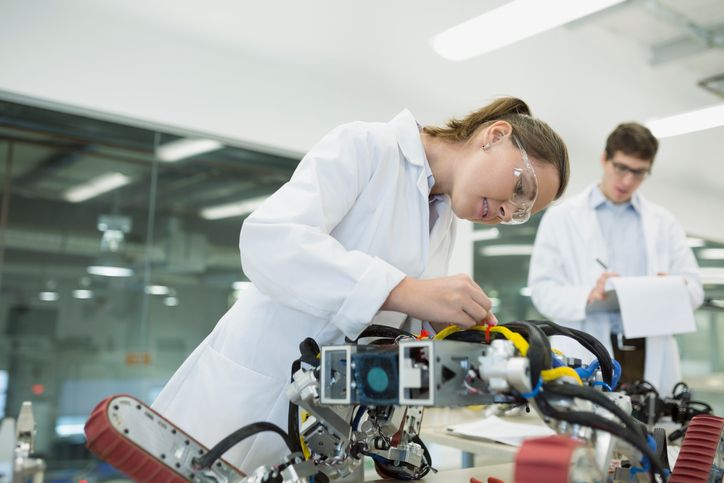 As manufacturers look to new technologies to automate processes, cobots are becoming a common starting point. Inexpensive, flexible and easy-to-program, these robots can easily automate tasks, and as the technology improves, their applications will only grow in the coming years.
As manufacturers look to new technologies to automate processes, cobots are becoming a common starting point. Inexpensive, flexible and easy-to-program, these robots can easily automate tasks, and as the technology improves, their applications will only grow in the coming years.
Universal Robots, one of the largest cobot makers in the world, reported another record year in 2017 with a 72 percent increase in revenue over 2016. Jürgen von Hollen, President of Universal Robots, credited it to not only improvements in its robots but also in continuing awareness of the technology and its applications.
Collaborative robots, more commonly known as “cobots” are gaining more widespread adoption because they’re flexible, easy-to-deploy, and can usually work near humans. They’re also relatively inexpensive (starting as little as $30,000) and can help manufacturers experience a quick return on investment by automating simple, repetitive processes. “The cobot market is expected to continue to be one of the key growth drivers in the automation market in the coming years,” said von Hollen.
“Manufacturers considering adoption collaborative robots should first think about processes, their system design and how their machines will support collaboration with human workers.”
According to the International Federation of Robotics, the global market for industrial automation will grow at a rate of 15 percent between 2018 and 2020 with demand for cobots at the forefront.
Some manufacturers are also starting to use cobots for more complex tasks. PSA Group, the second largest car manufacturer in Europe, has recently reduced production costs and improved factory performance through deployment of cobots. PSA Group deployed Universal’s UR10 Robots in an assembly system that improved worker economics and yielded cost savings of up to eight Euros per car for an initial cost savings of up to 1.6 million euros. The robots are mounted on a moving platform that goes under the vehicle in production. As operators move the vehicle into place, the cobot then manages the ergonomically challenging screw-driving operation.
The manufacturer programmed the robots in a month and implemented the system throughout its site in eight months, Jacob Pascual-Pape, General Manager of Southern Europe for Universal Robots told Robotics and Automation News. “UR cobots are now taking over tasks such as intricate screw-driving on the auto assembly line, relieving workers from ergonomically unfavorable work in a production environment that isn’t conducive to traditional industrial robots,” Pascaul-Pape said.
David Dechow, staff engineer for intelligent robotics and machine vision at Fanuc America Corp. told Design News that better vision will be a key for further adoption of collaborative robots moving forward. He says reaching that next level may require more years of development in the markets, but when that happens, use of the robots will explode. “The application base is huge…But it’s constrained by the types of things that robots can currently do. When that sensing technology blossoms, however, we’ll enter the next phase,” Dechow said.
Manufacturers considering adoption collaborative robots should first think about processes, their system design and how their machines will support collaboration with human workers. Samuel Bouchard, CEO of Robotiq, a leading maker of plug and play collaborative robot tools told Chief Executive last year that manufacturers need to start with a plan and understanding of the principles of robotics. Start with manual processes then create a robotic cell concept to fill the gap. From there, they can move onto other applications.
“Once people get their head around their first project, they understand the potential. They understand the limitations. We see a lot of people who bought a first robot six months or twelve months ago, who are deploying on a much larger scale these days,” Bouchard said.

Chief Executive Group exists to improve the performance of U.S. CEOs, senior executives and public-company directors, helping you grow your companies, build your communities and strengthen society. Learn more at chiefexecutivegroup.com.
0

1:00 - 5:00 pm
Over 70% of Executives Surveyed Agree: Many Strategic Planning Efforts Lack Systematic Approach Tips for Enhancing Your Strategic Planning Process
Executives expressed frustration with their current strategic planning process. Issues include:
Steve Rutan and Denise Harrison have put together an afternoon workshop that will provide the tools you need to address these concerns. They have worked with hundreds of executives to develop a systematic approach that will enable your team to make better decisions during strategic planning. Steve and Denise will walk you through exercises for prioritizing your lists and steps that will reset and reinvigorate your process. This will be a hands-on workshop that will enable you to think about your business as you use the tools that are being presented. If you are ready for a Strategic Planning tune-up, select this workshop in your registration form. The additional fee of $695 will be added to your total.

2:00 - 5:00 pm
Female leaders face the same issues all leaders do, but they often face additional challenges too. In this peer session, we will facilitate a discussion of best practices and how to overcome common barriers to help women leaders be more effective within and outside their organizations.
Limited space available.

10:30 - 5:00 pm
General’s Retreat at Hermitage Golf Course
Sponsored by UBS
General’s Retreat, built in 1986 with architect Gary Roger Baird, has been voted the “Best Golf Course in Nashville” and is a “must play” when visiting the Nashville, Tennessee area. With the beautiful setting along the Cumberland River, golfers of all capabilities will thoroughly enjoy the golf, scenery and hospitality.
The golf outing fee includes transportation to and from the hotel, greens/cart fees, use of practice facilities, and boxed lunch. The bus will leave the hotel at 10:30 am for a noon shotgun start and return to the hotel after the cocktail reception following the completion of the round.